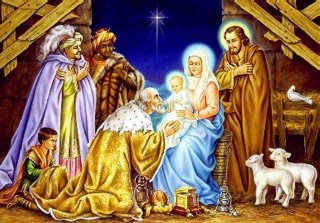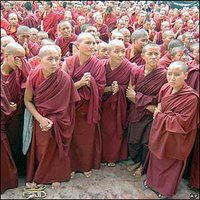In the Christian tradition of Christmas, we often see nativities that display Mary, Joseph (if you're lucky), some shepherds, baby Jesus in a manger (of course), angels, assorted barn animals and... wise men and the camels they rode in on. What's wrong with this picture?
 The wise men didn't show up until Jesus was living in a house (see Matthew 2:11). Of course, Mary and Joseph were only staying in the stable temporarily. It's to be assumed they'd want to move out and get back home as soon as possible. (IMHO there's something else wrong with this picture, but I'll discuss it at another time).
The wise men didn't show up until Jesus was living in a house (see Matthew 2:11). Of course, Mary and Joseph were only staying in the stable temporarily. It's to be assumed they'd want to move out and get back home as soon as possible. (IMHO there's something else wrong with this picture, but I'll discuss it at another time).Why were they in the stable?
Because there was a census taking place (see Luke 2) and all citizens were required to return to their birthplace during that census. Bethlehem was where Joseph was from and so naturally he took his pregnant fiance with him for the census because once you were engaged, you were seen to be as good as married. Since all the houses and inns were full, they ended up staying in the stables.
This was probably very common (though not much fun) for many of the travellers at that time. And because homes and inns were often structured around the animals, there wasn't much privacy. The animals were kept below, and some households lived in a level up from the animals, but exposed to the animals at all times.
Excavations have shown an arrangement where the house was made entirely out of mud and stone with a large pit in the middle of the house where the animals were kept. Then another level (up and out from the animal level) was where the family slept and cooked their meals. Picture it as shaped almost like a bowler hat, upside-down. It was often a convenient way to live because animals are warm in the winter and warm air rises. Often families slept on the rooftops in the summer.
So, Mary and Joseph were probably sleeping downstairs, but within sight of others who were staying upstairs. Not a lot of seclusion for an expecting mother.
There are four gospels in the Bible (Matthew, Mark, Luke and John) and each was written for a slightly different audience and by different authors, so each touches upon only what he thinks is important. Mark and John don't even feel that Jesus' childhood is significant, so there is no discussion of his birth.
The only mention of the wise men is in Matthew 2. Why is that?
The Book of Matthew was specifically targeted toward the Jews. The aim of the author was to tell the Jews that it was OK to believe that Christ was the Messiah predicted in the Old Testament. Since the Old Testament prophesies pointed to Jesus as being King of the Jews, it was very important to establish his lineage. How do you do that, if you're Matthew?
You discuss Joseph's ancestors, since the right to kingship is passed through the father's side. Mary also seemingly had a royal lineage, and it's possibly detailed in Luke (although there's debate about that).
You also discuss how important his birth was to everyone, and how it was heralded and even indicated by signs: "Now after Jesus was born in Bethlehem of Judea in the days of Herod the King, behold, magi from the east arrived in Jerusalem, saying "Where is He who has been born King of the Jews? For we saw His star in the east, and have come to worship Him." (Matt. 2:1-2)
 So who were these magi, where did they come from, and why did they bring "...gifts of gold and frankincense and myrrh"? Matthew doesn't give us a lot of details.
So who were these magi, where did they come from, and why did they bring "...gifts of gold and frankincense and myrrh"? Matthew doesn't give us a lot of details.We know they came from the east but we don't know how long they travelled to get to Jerusalem. So, they probably would have been of middle eastern or asian descent.
Frankincense and myrrh are both resins (dried tree sap) that come from trees of the genus Boswellia (frankincense) and Commiphora (myrhh), which are common to Somalia. But that doesn't necessarily indicate that any of them were from Africa (which was west of Jerusalem) since traders went everywhere. It also doesn't exclude any nationality, since people were known to travel far away from their birthplaces.
 They all were considered to be very wise and possibly practiced some form of magic (the word magi is the root for the word magician). There's no indication that they were kings, and so I would definately question the hymn "We Three Kings" (although I still love it).
They all were considered to be very wise and possibly practiced some form of magic (the word magi is the root for the word magician). There's no indication that they were kings, and so I would definately question the hymn "We Three Kings" (although I still love it).They probably would have studied together, and they must have taken their beliefs very seriously if they travelled so far to worship Jesus so it might even indicate a buddhist monastery. We simply don't know.
We know that some of their beliefs probably included astrology, since they took the star seriously. However, perhaps the star would have been taken seriously by anyone at the time but most people didn't guess what it indicated. We have no knowlege about it's appearance, so we can only surmise.
Additionally, we have no idea how many magi there were. They probably represented a community, and there may have been as little as 2 or they could have numbered in the hundreds. They certainly impressed Herod when they approached him, and it wasn't always easy to get an audience with him! In fact, Herod was impressed enough to kill every male (age 2 and under) in Bethlehem in order to eliminate the competition (Mary and Joseph had already whisked Jesus away to Egypt for a while).
Why the gifts of gold, frankincense and myrrh? I have been burning frankincense and myrrh daily, and it smells wonderful. But not only were they burned for fragrance, they were used in toiletries and oils. They were products that were very expensive, and they would have been considered a frivolity for anyone less than royalty. These were gifts that were fit for a King. And thus Matthew's case was made.

